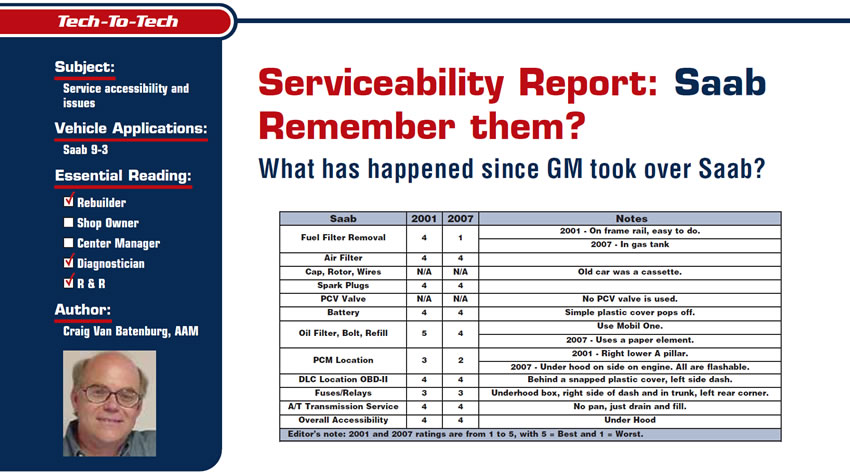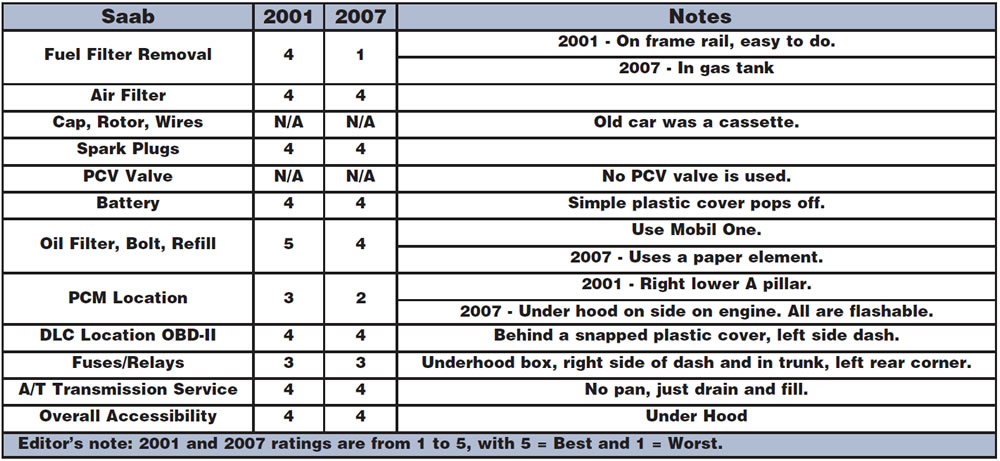
Tech to Tech
- Subject: Service accessibility and issues
- Vehicle Application: Saab 9-3
- Essential Reading: Rebuilder, Diagnostician, R & R
- Author: Craig Van Batenburg, AAM
Remember them? What has happened since GM took over Saab?
So far, we have reviewed Japanese, Korean, English, German and domestic vehicles – vans, trucks and cars. Are the Swedish better at serviceability? Many of us remember the old Saab two-strokes, mixing the oil in the gas. Today’s commercials explain the Saab story with jets flying overhead. General Motors Corp. bought Saab in 1990, and sales haven’t been all that good since the new owner took over. I went on a mission to discover more about this somewhat-forgotten brand. What did I find out? I used the Saab 9-3 for my study.
Before Saab made cars, it made planes. And Saab’s very first automotive project, the 92.001, was handmade by a team of aviation experts. Not coincidentally, its aerodynamic profile resembles an airplane wing. The 92.0001 was powered by a DKW 18-hp two-cylinder, two-stroke engine, an Auto Union fuel tank and other components that – as legend has it – were salvaged from a junkyard.
In 1990 Saab was split in half and the car operations – excluding the truck, bus and military-jet businesses – were put under the control of GM. A decade later, GM bought the remainder of Saab’s automotive operations from its partner. GM had the idea of turning Saab into another BMW, so it initially planned to produce a model to rival the BMW’s 7 series.
From then on, GM struggled with the Saab’s identity. It has lost money in every year but one since the acquisition. How much has Saab cost GM since 1990? From what I have discovered, it is estimated at $4 billion dollars per year. It is rumored that Saab is for sale.
What’s wrong with GM’s approach to Saab? The old Saab cars were good, but strange; they had offbeat customers who loved them. The cars had front-wheel drive at a time when most everything else had rear-wheel drive. Saab’s ignition-key slot was, and still is, on the console, and the engine was mounted backward in the old 900-series car. Saab’s strongest markets in this country were in New England and the coasts. Simply put, the older Saabs (pre-1990) were different and dependable. Then along came all the other front-wheel-drive cars, led by Honda. The older Saab 9-3 was produced in Trollhattan, Sweden, although the convertible (Cabriolet) version was made under license in Austria. It shared platforms with the Opel Vectra and the Cadillac BLS.

The car is badged as a 93, although Saab consistently advertises it as the 9-3. The 9-3 was introduced in 1998 and was replaced by a newly developed 9-3 in the 2003 model year. It was in 2003 that GM installed its engines and really made it a GM car. The Saab 93, pronounced “ninety three,” was a car produced by Saab from 1955 to 1960.
The first-generation 9-3, a substantially improved last-generation Saab 900, was launched in 1998 for the 1999 model year. It was the last smallish Saab to use the company’s H engine. The 9-3 was greatly improved over the Saab 900 with a better ride and handling; it also substantially improved in crashworthiness with standard side-impact airbags, head protection and active headrests. Both the Saab 9-5 and Saab 9-3 were the first cars in the world to earn the maximum score in a side impact, based on EURONCAP testing, ahead of the next best: the Volvo S70. The Swedish do deserve their reputation for safe cars. It was also available with the B204E, a new light-pressure turbo engine based on the B204L used in the last-generation Saab 900.
The second-generation model was first shown at the Detroit Auto Show in early 2003. All U.S.-market gas-powered variants featured a 2.0 L-4 engine derived from the GM Ecotec family and are all turbocharged. There are three different versions of the turbocharged inline four, with the amount of turbo boost determining the power output.
Power in the 9-3 was delivered through the front wheels only. It was and is available as a four-door sedan, a wagon and a two-door convertible. It is the safest car in its class, including innovations such as Saab Active Head Restraints (SAHR II) to reduce whiplash and ReAxs, passive rear-wheel steering to reduce understeering and passive toe-in under heavy braking. Out of these models, the convertible (manufactured by Magna Steyr in Austria beginning in 2003) is the best known and is the best-selling in its class in many markets.
The 9-3 and the Opel Vectra were the first of the global GM Epsilon platform, which was then lengthened to accommodate four new cousins: the Chevrolet Malibu/Malibu MAXX, Pontiac G6 and the Saturn Aura. Even so, this platform was heavily re-engineered by SAAB, making it 60% exclusive and rendering it impossible to build outside its Trollhattan plant. An auto-directional rear axle, a proprietary optical-fiber electric/electronic system and the possibility of all-wheel drive (offered in 2008) are some of the SAAB exclusive features.
So we have a Saab with many parts and designs from GM. In this global market, sharing engineering, platforms and components makes economic sense. When we mix up parts, what does that do to serviceability? I see a lot of cost cutting at the expense of technicians’ busted knuckles and frustration.
I spoke with Al Rutman at Patrick Saab in Auburn, Mass., a 27-year veteran at that Saab dealership. He had a great perspective on the Saabs he works on daily. “Overall, the older Saabs were a bit better, but GM has improved the electronics and the Tech 2 scanner does a good job in helping me out,” he said to me. Another dealership technician told me that the old Saab tech support was great and now it is so bad they don’t even call. As some things have gotten better for the technicians, other areas have gotten worse. It seemed like a wash to me. Overall, the technicians who work on Saabs like them, but water-pump replacements are common and a pain in the posterior.
What about the cars themselves? The ignition cassettes are a problem. Think of them as four coil-on plugs (COPs) all molded together. One is defective, and you buy four. This is no longer the case, as they are now individual.
One problem that cropped up on certain sports-sedan and convertible passenger vehicles was a vacuum-pipe checkvalve for the brake booster that failed from exposure to elevated temperatures. This could result in sudden loss of power-brake assist, usually with little or no warning. Dealers will install a new redesigned checkvalve. The recall began March 17, 2006.
The 2001 Saab 9-3 has problems with the fuel-pump retaining tabs holding the fuel lines to the pump. The tabs were damaged during production, and over time this caused the fuel lines to loosen from the pump, resulting in fuel leakage. If an ignition source were present, the fuel might ignite, resulting in a vehicle fire. Dealers installed a securing bracket that secured the fuel lines to the fuel pump.
My research leads me to recommend the use of Mobil One. Period. The engines need synthetic oil. And about those 15K service intervals, get real. Use your common sense when it comes to working on and servicing these Swedish/American cars.
Ups – Quality got better in the electronics. The cars handle very well and normal service is easy. A Tech II scan tool does the job well.
Downs – Sales are so slow that it’s not clear what the future holds for Saab technicians. Some jobs, as in any car, make you want to take a personal day.
Overall rating: The Saab quality is slightly better than before, and the ease of service is about the same. This car is not a big problem for technicians who don’t service them on a regular basis, because so much is GM-based.

Craig Van Batenburg, AAM, is the owner of the Automotive Career Development Center (ACDC), www.autocareers.org, and delivers management and technical seminars nationwide. He formerly owned Van Batenburg’s Garage Inc. in Worcester, Mass., for more than 25 years. Van Batenburg is ASE master and L1 certified, with advanced skills in hybrid drive systems. You can reach him by e-mail at [email protected].
The copyrighted article featured above is reprinted with the permission of AutoInc., the official publication of the Automotive Service Association (ASA). To learn more about ASA and its commitment to independent automotive-service and repair professionals, visit www.asashop.org or call 800-272-7467.













